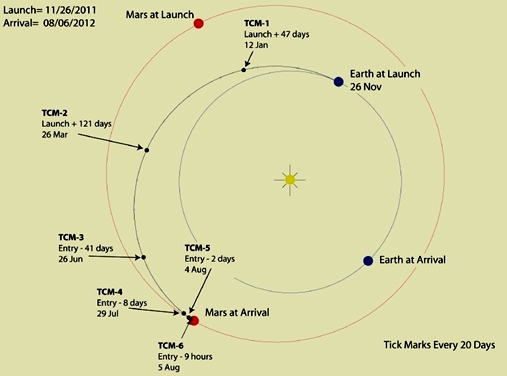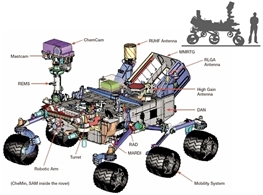.check to a description of Curiosity landing
last updated: April 21st, 2015
 back Space
back Space
![]() LATEST! On April 16, 2015, the Curiosity rover passed the 10-kilometer (6.214-mile) mark since its 2012 landing
LATEST! On April 16, 2015, the Curiosity rover passed the 10-kilometer (6.214-mile) mark since its 2012 landing
.check to a description of Curiosity landing
last updated: April 21st, 2015
Launched on November 26th, 2011, by 10:02 a.m. EST, aboard a United Launch Alliance Atlas V, from the CCAFS, Kennedy Space Center, Space Launch Complex 41, rover Curiosity is a NASA's large, six-wheeled rover to the surface of Mars. The rover will explore the red planet during 2 years, searching sites which might harbour life building blocks. Analysis of rocks will be available from a distance through laser pulses. The mission is managed by NASA's Jet Propulsion Laboratory, Pasadena, Calif., a division of the California Institute of Technology. Curiosity target was the foot of a mountain of sedimentary strata, or layers, located inside Gale Crater, at 4.6 degrees south latitude, 137.4 degrees east longitude. Gale Crater spans 96 miles (154 kilometers) in diameter and displays a atypical aspect due to that mound which is different from any central peak. The 'mountain' is a mound informally named Mount Sharp, rising about 3 miles (5 kilometers) above the crater floor. Several craters on Mars contain mounds or mesas that may have formed in ways similar to Mount Sharp, as such mounds might be remnant masses inside once completely filled craters. That family of craters might have been filled or buried and then exhumed or partially exhumed which could have been due to amounts of water filling into the crater at a time when Mars was wet. The slopes of Mount Sharp are gentle enough for Curiosity to climb. Gale Crater was named in 1991 for Australian astronomer and banker Walter F. Gale (1865–1945), who discovered several comets and drew maps of Mars and Jupiter. The site of landing for Curiosity has been opted for in the summer of 2011 as the Mars Science Laboratory officially got his name, of 'Curiosity', in May 2009. The area at Gale Crater accessible to Curiosity as it drives during the mission contains rocks and soils that may have been originally deposited under differing conditions over a range of time. Curiosity, formerly the 'Mars Science Laboratory,' will have far more capacities than all the previous rover missions which landed at the surface of Mars, with a radioisotope power supply relieving the craft from reliance on sunshine
 | A view of the Mars Science Laboratory mission between Earth and Mars!. courtesy site 'Amateur Astronomy' |
Curiosity has the following dimensions, with 9 feet, 10 inches (3.0 meters) in length, 9 feet, 1 inch (2.8 meters) in width, and 7 feet (2.1 meters) in height at the top of mast. Robotic arm length is 7 feet (2.1 meters) as each wheel has a diameter of 20 inches (0.5 meter. The rover is weighing 1,982-pound (899-kilogram). Curiosity has been featured with varied tools which will help into its mission as it is powered by a multi-mission radioisotope thermoelectric generator and lithium-ion batteries. A key capability in the new version is image processing to check for obstacles. This allows for longer drives by giving the rover more autonomy to identify and avoid potential hazards and drive along a safe path the rover identifies for itself. The rover also has a 'dream mode', which allows the 1-ton robot to save energy while performing vital functions and monitor what's going on when it is asleep while its computer is turned off
 | click to a view of rover Curiosity with a comparison in scale between the rover and a human. courtesy site 'Amateur Astronomy' |
In terms of instrumentation, rover Curiosity is sporting the following.
Such tools have been deviced by varied space agencies, institutions and laboratories with a important contribution from Europe, or France, for example. Curiosity has three antennas for telecommunication. Two are for communications directly with NASA’s Deep Space Network antennas on Earth using a radio frequency in the X band (7 to 8 gigahertz). The third is for communications with Mars orbiters, using the ultra-high frequency (UHF) band (about 400 megahertz). In terms of communications, while the rover can send direct messages, it communicates more efficiently with the help of current missions in orbit around Mars, including NASA's Odyssey and Mars Reconnaissance Orbiter, and the European Space Agency's Mars Express. NASA's Deep Space Network of antennae across the globe receive the transmissions, and send them to the Mars Science Laboratory mission operations center. Curiosity has redundant main computers, or rover compute elements. Of this “A” and “B” pair, it uses one at a time, with the spare held in cold backup. Thus, at a given time, the rover is operating from either its “A” side or its “B” side. Most rover devices can be controlled by either side. Each rover compute element contains a radiation-hardened central processor with PowerPC 750 architecture operating at up to 200 megahertz speed, compared with 20 megahertz speed of the single RAD6000 central processor in each of the Mars rovers Spirit and Opportunity. Each of Curiosity’s redundant computers has 2 gigabytes of flash memory (about eight times as much as Spirit or Opportunity), 256 megabytes of dynamic random access memory and 256 kilobytes of electrically erasable programmable read-only memory
Website Manager: G. Guichard, site 'Amateur Astronomy,' http://stars5.6te.net. Page Editor: G. Guichard. last edited: 8/28/2012. contact us at ggwebsites@outlook.com